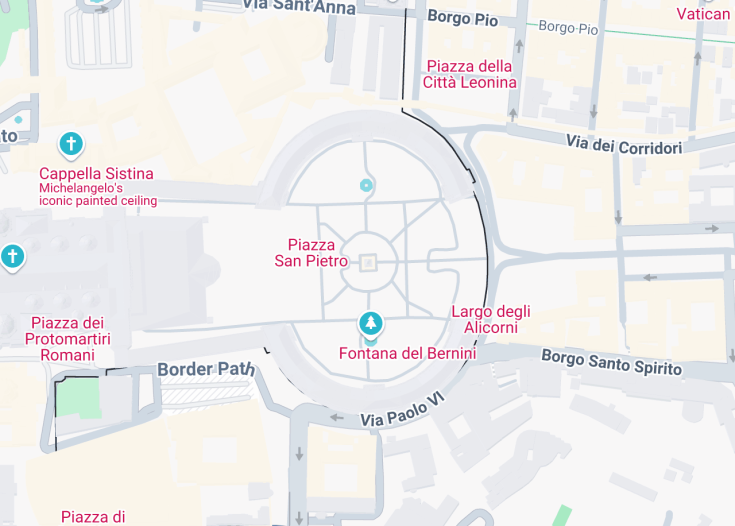The Vatican Obelisk, an ancient Egyptian monument, is a striking centerpiece in St. Peter’s Square in Vatican City. Standing at a remarkable height of 25.3 meters, it symbolizes the triumph of Christianity over Paganism. This iconic structure, originally erected in Heliopolis, has a rich history intertwined with Roman antiquity.
Visitors are encouraged to arrive early in the morning to enjoy a quieter experience at St. Peter’s Square. This prime time allows for unobstructed views of the obelisk and the chance to appreciate its historical significance without the crowds.
To enhance your visit to the Vatican, consider securing a guided tour that includes the obelisk. This will provide deeper insights into its fascinating history, including its relocation in the 16th century, adding a layer of context to this remarkable landmark.
The Majestic Vatican Obelisk: A Monument of History and Faith
The Vatican Obelisk, located in the iconic St. Peter’s Square in Vatican City, stands as a monumental tribute to ancient engineering and religious significance. Erected in 40 AD by Emperor Caligula, this towering structure measures an impressive 25.3 meters, topped with a cross that elevates its height to nearly 40 meters when including its base adorned with bronze lions. Originally hailing from Heliopolis, Egypt, the obelisk symbolizes the triumph of Christianity over paganism, making it a powerful emblem for visitors. The Vatican Obelisk has survived the test of time, never having fallen since its arrival in Rome. Its relocation in 1586 under Pope Sixtus V involved remarkable engineering techniques, showcasing the determination of the era. Seeing this ancient artifact amid the bustling square filled with pilgrims and tourists offers a profound connection to history and faith, making it a must-visit for anyone exploring the heart of Rome.
Engaging Activities at the Vatican Obelisk in St. Peter’s Square
Visitors to the Vatican Obelisk can enjoy a variety of attractions and activities that enhance their experience.
Strolling in St. Peter’s Square
Immerse yourself in the grandeur of St. Peter’s Square as you walk around this historic site, where the obelisk takes center stage. The square’s architecture, designed by Bernini, creates a welcoming atmosphere for individuals and groups.
Photography and Reflection
Capture stunning photographs of the obelisk against the backdrop of St. Peter’s Basilica. This iconic monument offers a perfect spot for personal reflection and contemplation amidst the busy surroundings.
Guided Tours
Consider joining a guided tour that includes the Vatican Obelisk as part of the itinerary, providing insights into its rich history and architectural significance. Such tours often include fascinating anecdotes that connect with the broader narrative of Vatican City.
An Interesting Fact About the Vatican Obelisk
One intriguing detail about the Vatican Obelisk is its relocation in 1586, which marked it as the first ancient obelisk in Rome to be raised in modern times. Under the guidance of architect Domenico Fontana, this massive stone was transported with remarkable precision, employing 800 men and 160 horses in just one day. The effort was not merely an engineering feat but symbolized the victory of Christianity over the remnants of paganism. Additionally, it was rumored that a bronze globe atop the obelisk contained the ashes of notable figures like Julius Caesar. Although later inspections disproved this, the globe became part of a journey to various locations before settling into the Palazzo dei Conservatori. This blend of legend and history captivates tourists and continues to fascinate scholars and visitors alike.
Experience the Majestic Vatican Obelisk at St. Peter’s Square
The Vatican Obelisk stands as a towering symbol of history and spirituality, inviting visitors to delve into its rich past. Erected in St. Peter’s Square, this ancient monument draws the eyes of pilgrims, tourists, and history enthusiasts alike. With a stunning height of 25.3 meters and the impressive cross that crowns it, reaching nearly 40 meters with its base, the obelisk serves as a magnificent centerpiece to the bustling square.
This iconic structure, originating from Egypt, offers insight into both ancient history and the evolution of Christianity. Originally erected in Heliopolis, it was brought to Rome by Emperor Caligula and later relocated by Pope Sixtus V in 1586. The story of its relocation is a testament to human ingenuity; the feat involved 800 men and numerous horses and winches, truly reflecting the dedication to preserving its history.
Visitors can expect to witness the obelisk’s grandeur against the backdrop of St. Peter’s Basilica, making it an ideal spot for photography enthusiasts. The interplay of light throughout the day adds a dynamic element to its viewing experience, offering unique perspectives at sunrise and sunset.
The Vatican Obelisk is particularly suitable for those with a keen interest in archaeology, religion, or art history. With informative plaques and guided tours available, guests can gain a deeper understanding of its significance. Don’t forget to keep an eye out for the bronze cross atop the obelisk, rumored to contain a relic of the True Cross, enriching its spiritual allure.
As part of a broader itinerary, the obelisk serves as a fantastic starting point for exploring not only St. Peter’s Basilica but also nearby attractions, such as the Vatican Museums and the beautiful gardens that surround the Vatican City. Plan to set aside ample time to soak in its serene atmosphere and appreciate the intricate details that adorn the square.
For those wishing to bypass the usual tourist crowds, consider visiting during off-peak hours. Early mornings or late afternoons are particularly serene times to appreciate the monument without the hustle of larger groups.
The Best Time to Visit the Vatican Obelisk at St. Peter’s Square
To truly appreciate the beauty and significance of the Vatican Obelisk, the best time to visit is during the early morning or late afternoon when the light enhances its grandeur and fewer visitors are present.
Special Events to Consider
Attending Mass on Wednesdays or Sundays, especially when led by the Pope, presents a unique opportunity to see the obelisk at its most vibrant. The square fills with energy during these occasions, creating a spiritually enriching experience.
Accessibility and Limitations
The Vatican Obelisk is generally accessible for visitors of all abilities, ensuring that everyone can appreciate its historic significance.
Accessibility
Limitations
- Large crowds during peak tourist seasons may hinder your experience.
- Certain areas around the obelisk may be restricted during special events.
- Photography may be limited in areas of worship near the obelisk.
Notes to visitors
- Silence is expected in the vicinity as a sign of respect for the sacred space.
- It is advisable to dress modestly when visiting.
- Security measures are in place at the entrance to St. Peter’s Square, so be prepared for checks.
General Information
Essential details for your visit to the Vatican Obelisk at St. Peter’s Square.
Location
Located in the heart of Vatican City, the obelisk is surrounded by iconic landmarks such as St. Peter’s Basilica, the Vatican Museums, and the Sistine Chapel, making it a central feature of the area.
Address:
Piazza San Pietro, 00120 Città del Vaticano, Vatican CityVisiting Information
The Vatican Obelisk is open to the public and can be visited freely throughout the day. The best times to enjoy the obelisk are during the early morning or late afternoon when the lighting enhances its beauty.
How to Reach the Vatican Obelisk at St. Peter’s Square
Getting to the Vatican Obelisk is straightforward from the city center. Here’s how to reach this magnificent site:
Car
The Vatican Obelisk is easily accessible by car, with nearby parking available for a fee. However, street parking is limited.
| Route | Distance | Travel Time |
|---|---|---|
| From Termini Station | 2.6 miles (4.2 km) | 15 minutes |
| From Piazza Navona | 1 mile (1.6 km) | 10 minutes |
| From Villa Borghese | 1.5 miles (2.4 km) | 8 minutes |
Public Transport
Utilizing public transport is another convenient option. The nearest metro station is Ottaviano (Line A), followed by a short walk to the obelisk.
| Route | Distance | Travel Time |
|---|---|---|
| From Termini Station (Metro) | 3.4 miles (5.5 km) | 20 minutes |
| From Piazza Navona (Bus) | 1 mile (1.6 km) | 15 minutes |
| From Trastevere (Tram) | 2.3 miles (3.7 km) | 25 minutes |
Nearby Attractions
- St. Peter’s Basilica – 0 meters (0 miles)
- Vatican Museums – 300 meters (0.2 miles)
- Sistine Chapel – 500 meters (0.3 miles)
- Castel Sant’Angelo – 1.2 kilometers (0.8 miles)
- Piazza Navona – 1.5 kilometers (0.9 miles)
- Campo de’ Fiori – 1.8 kilometers (1.1 miles)
- Palazzo Venezia – 2 kilometers (1.2 miles)
- Capitoline Museums – 2.2 kilometers (1.4 miles)
- Roman Forum – 2.5 kilometers (1.6 miles)
- Colosseum – 3 kilometers (1.9 miles)
- Villa Borghese – 3.5 kilometers (2.2 miles)
- Piazza della Repubblica – 3.9 kilometers (2.4 miles)
Common Questions
What is the history of the Vatican Obelisk in St. Peter's Square?
The Vatican Obelisk, an ancient Egyptian artifact, boasts a rich history dating back to its origin in Heliopolis, Egypt. It measures approximately 25.3 meters in height, constructed from red granite, and stands as a significant symbol in St. Peter’s Square.
The obelisk was transported to Rome during the reign of Emperor Caligula in 40 AD, finding its first home at the center of the Circus of Nero. Following this period, it remained in this spot even after the circus’s decline, surrounded by a necropolis. Pope Sixtus V saw the obelisk’s relocation as a means of showcasing the triumph of Christianity over paganism.
On September 10, 1586, the obelisk underwent a remarkable move to its current location, directed by architect Domenico Fontana. The operation required significant manpower and resources, employing around 800 men and 160 horses to successfully erect the obelisk in St. Peter’s Square after 800 feet of transportation. This raised the obelisk first in modern Rome since antiquity.
What is the significance of the Vatican Obelisk in relation to Christianity?
The Vatican Obelisk holds deep symbolic significance in relation to Christianity, particularly due to its historical context and the circumstances of its relocation. Initially erected in Egypt as a pagan symbol, its movement to St. Peter’s Square in 1586 reflects Pope Sixtus V’s intention to demonstrate the triumph of Christianity over pagan beliefs.
By placing the obelisk in a prominent location near the New St. Peter’s Basilica, it serves as a visual representation of the authority and presence of the Church. Moreover, the cross that was placed atop the obelisk signifies the centrality of the Christian faith and serves as a modern pilgrimage point for visitors and faithful alike. The obelisk is therefore not merely an ancient artifact but a testament to the enduring nature of Christianity.
Who oversaw the relocation of the Vatican Obelisk?
The remarkable relocation of the Vatican Obelisk was overseen by Pope Sixtus V in 1586 and conducted under the expert direction of architect Domenico Fontana. Fontana was an accomplished engineer who had gained recognition for his work in Rome’s urban planning. His careful planning and execution were pivotal in the successful move of this enormous obelisk.
The process required extensive preparation over 13 months and involved the collaboration of around 800 workers and 160 horses. This monumental task showcased the engineering prowess of the time and demonstrated Fontana’s skills in managing such a formidable project.
Additionally, the astronomer Ignazio Danti was involved in providing the necessary calculations and assistance during this ambitious undertaking. The successful relocation marked a significant event in the history of Rome, being the first of its kind in modern times.
What materials and design features characterize the Vatican Obelisk?
The Vatican Obelisk is constructed from red granite, making it a notable example of ancient Egyptian craftsmanship. Standing at a height of 25.3 meters, its imposing figure is accentuated by its considerable base and the large cross that sits atop it, bringing the total height to nearly 40 meters.
Its design features a smooth, tapering form typical of ancient obelisks, adorned with inscriptions and symbols during its time of origin, though intriguingly, this specific obelisk is devoid of hieroglyphs, which has led to various theories regarding its history.
The base of the obelisk includes four bronze lions crafted by artist Prospero Antichi, and this base adds a significant artistic dimension to the overall structure. Together, these elements – the height, material, and design – impart a sense of grandeur and historical significance to the Vatican Obelisk, making it a focal point of admiration within St. Peter’s Square.
What legends are associated with the Vatican Obelisk?
Over the centuries, the Vatican Obelisk has become the center of various legends and myths. One of the most notable medieval stories suggests that the ancient bronze globe that topped the obelisk held the ashes of renowned figures such as Julius Caesar or Trajan. This captivating narrative added an air of mystery to its historical significance.
When the obelisk was relocated in 1586, this globe was initially displayed at the Marforio fountain before eventually finding its place on the balustrade of the Piazza del Campidoglio in 1692. It was later moved to the Palazzo dei Conservatori in 1848, where it remains today.
Additionally, it is said that Pope Sixtus V, believing it contained a particle of the True Cross, granted a significant indulgence to those who venerated the cross placed on top of the obelisk. Although no such relic was found during restorations, this adds another layer of religious significance to the obelisk’s history, intertwining it with the lore of the Christian faith.

Is the Vatican Obelisk at St. Peter’s Square in Rome Worth Visiting?
The Vatican Obelisk is undoubtedly a significant attraction for anyone visiting St. Peter’s Square in Rome. Standing at an impressive height of 25.3 meters, this ancient Egyptian landmark dates back to around 40 AD and is steeped in rich history. It was moved to its current location by Pope Sixtus V in a remarkable feat of engineering, making it one of the first obelisks to be relocated in modern times.
Beyond its impressive size, the obelisk symbolizes the triumph of Christianity over paganism, adding a deeper layer of meaning for visitors. The narrative surrounding its relocation, involving Domenico Fontana and a team of men and horses, further enhances its allure. Moreover, the obelisk’s connection to events such as the granting of indulgences adds to its historical gravity. Therefore, a visit here is not just for the sights but for the stories woven into this monumental structure.









